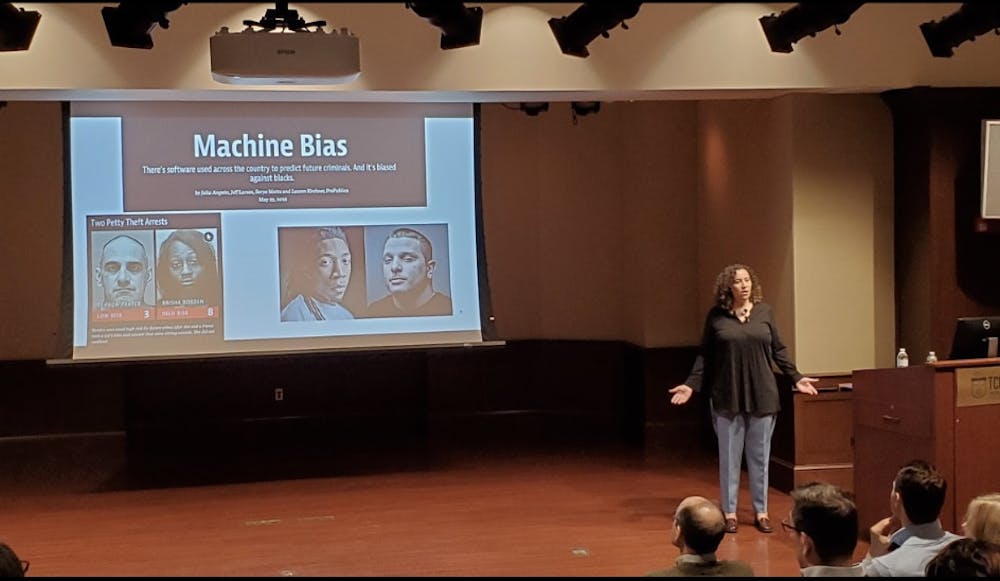By Catherine Gonzalez
Staff Writer
On Wednesday, associate professor at New York University and author Meredith Broussard came to the Library Auditorium at 5:30 p.m. to promote her new book, “More Than a Glitch: Confronting Race, Gender, and Ability Bias in Tech,” and share findings from her research on artificial intelligence (AI).
After facing race and gender-related disadvantages in the programming field, Broussard pursued her interest in computer science by entering into AI-focused data journalism.
“I just got really interested in human problems and how they manifest in technology,” Broussard said.
Broussard told attendants that AI is created from patterns formed by inputted data.
“It’s really gorgeous, beautiful math,” Broussard said. “It’s really cool, but it is also discriminatory.”
AI is subjective, but Broussard explained that a common misconception of AI is that it is objective.
“I had no idea before that AI was biased in any way,” said freshman public health major Naomi Pirani.
This misconception is disproven by examples including soap dispensers, facial recognition and mortgage-approval algorithms, all of which include some degree of racial and gender-based discrimination. In the instance with a soap dispenser, a person of color could only get it to work by placing a white paper towel underneath it. The machines discriminate against people because the data put into AI comes from a world with biases.
Students were amazed at the relevance of these findings in their own lives and the context they received about it from Broussard.
“My professor was just talking about how there are racist policies that go behind mortgage approvals, and at the time, I was kind of confused about what she was talking about, but to hear that there is something behind it, and to hear [Broussard’s] explanation about why that is, was really cool to put two and two together,” said Ebony Riley, a freshman English major.
When Broussard had breast cancer, she decided to run her mammogram scans through an AI machine to test whether it could detect her cancer, and if not, whether there were any racial behind why that is.
“It worked, but it didn’t work the way I expected, which really surprised me,” Brossard said. “I put in an image, and it put a box around my cancer, and that was it.” What shocked her most was that there were no accompanying numbers regarding the percent (she later found out that AI cannot say the percent change because of legal liability). The AI only included a decimal number. While her racial disparity theory did not work, she said she had later discovered cancer studies that showed racial disparities.
Broussard described the importance of closely monitoring AI machines and making decisions from there about whether a particular machine is doing more harm than good.
“Have the human and the machine work together as a team,” Broussard said. “We need to give ourselves the opportunity to not use AI if it’s not the right choice. It may be hard to do if the money’s already been spent, but it is possible.”
Broussard also emphasized the importance of bias-related experiences not being “one size fits all” for any particular group, whether it be regarding race-based or disability-based disadvantages, and working with that knowledge as opposed to ignoring it.
“We have to listen to individual people’s experiences,” Broussard said.
Broussard believes that changing the narrative about AI will help people stay more focused on improving upon it so it can work to its fullest potential for all people.
“We can emphasize the realities of AI instead of the fantasies,” Broussard said.
Broussard acknowledged that the many ways to improve upon the current AI-situation may be overwhelming to think about but reassured future journalists that they need not panic.
“Nobody does all of the things by themselves,” Broussard said. “You’ll be introduced to all of these things, and then you’ll choose one or two of them that you’re good at, and then specialize in it and find people who are good at other things and collaborate with them.”
For those who wish to get started learning about AI, Broussard recommended a variety of films and books, including the film “Coded Bias” in which Broussard is featured, as well as her most recent book.







